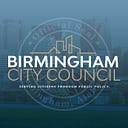Neighbors of Industry: Touring the 35th Ave. Superfund Site

Black soot from a nearby industrial plant can be seen on the houses throughout the communities in North Birmingham, several of which fall within the current boundary of the federal Superfund site designated by the U.S. Environmental Protection Agency.
On Wednesday, Birmingham City Councilors, the Mayor, U.S. Rep. Terri Sewell and other elected officials set out to tour some of these communities and speak with those living under the clouds of industry.

In 2012, the EPA designated a stretch of land in North Birmingham as a Superfund site — a federal program that cleans up uncontrolled hazardous wastes. The stretch of land is home to several large industrial facilities and also includes residential portions of Collegeville, Harriman Park and Fairmont. The Superfund designation was due to high levels of industrial pollutants such as arsenic, lead and benzo(a)pyrene found in soil samples taken in the area.

“We appreciate the work that’s been done by the EPA and the community stakeholders,” Councilor William Parker said following a meeting with elected officials and EPA representatives. “We look at this as an opportunity, not a challenge. We’re going to roll our sleeves up and get to work. I can truly say the North Birmingham communities’ best days are to come.”

On August 7, Mayor Randall Woodfin penned a letter to EPA leadership urging the agency to place the 35th Ave. Superfund site on the National Priorities List (NPL), which would unlock more federal funding to assist in remediation efforts.

In part, the letter reads, “As a result of these illegal actions, thousands remain at risk including the 1,070 people living in 394 public housing units and 751 children attending Hudson K-8 school,” Woodfin wrote. “The necessary remedies include, but are not limited to, screening and health care to address pollution related health issues, relocation and reconstruction of Hudson K-8 school, non resident development of the North Birmingham 35th Avenue Superfund site and reclamation of Village Creek.”
Congresswoman Sewell said that following the conviction of former State Rep. Oliver Robinson — who was found guilty on bribery charges surrounding his involvement in downplaying the severity of the pollution in North Birmingham — one of the major concerns is winning back the trust of the community.

“There have been 390 sites that have had removal take place,” Sewell explained during the press conference. “There are another 127 sites that still need removal. We were able to get a commitment from the EPA that those sites will be remediated. What’s concerning us is there are about 500 sites that are either abandoned or people refuse to allow the EPA to test and remove [contaminated soil]…We’ve been working with stakeholders to try and get public confidence back to allow the EPA to go on site and do that. It’s critically important to have active members of the community engaged with these efforts.”
There are an additional 139 sites that have not been yet been tested for industrial contamination by the EPA, according to officials. Having the 35th Ave. Superfund site placed on the NPL could significantly help with those efforts. So far roughly $20 million in federal funds have been spent on remediation efforts in North Birmingham.

Sewell said she hopes that the 35th Ave. site will be added to the NPL and the potentially responsible parties named by the EPA will provide funding for the cleanup of industrial contamination that has fallen on North Birmingham.
“None of the potentially responsible parties have put any money toward the cleanup,” Sewell said. “I think it would be important for us to get those federal taxpayer dollars back from these potentially responsible parties who have not yet stepped up to the plate.”
Councilor John Hilliard said he is dedicated to making sure the industries that have contributed to the wide-spread pollution in the residential are held responsible for their actions. “We’re not going to stop until this is made right,” Hilliard said. “These people deserve to breathe clean air and have clean soil for their kids to play in. Anything less than that is simply unacceptable to me.”
